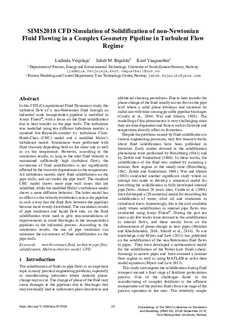CFD Simulation of Solidification of non-Newtonian Fluid Flowing in a Complex Geometry Pipeline in Turbulent Flow Regime
Journal article, Peer reviewed
Published version
Permanent lenke
http://hdl.handle.net/11250/2590619Utgivelsesdato
2018Metadata
Vis full innførselSamlinger
Sammendrag
In this CFD (Computational Fluid Dynamics) study, the turbulent flow of a non-Newtonian fluid through an industrial scale transportation pipeline is modelled in Ansys Fluent®, with a focus on the fluid solidification due to heat transfer on the pipe walls. The turbulence was modelled using two different turbulence models: a standard low-Reynolds-number k-e turbulence Chan-Hsieh-Chen (CHC) model and a modified Malin’s turbulence model. Simulations were performed with fluid viscosity depending both on the shear rate as well as on the temperature. However, according to the simulation results, as long as the inlet fluid velocity is maintained sufficiently high (turbulent flow), the occurrence of fluid solidification is not significantly affected by the viscosity dependence on the temperature. All turbulence models show fluid solidification on the pipe walls, and not inside the pipe itself. The standard CHC model shows more pipe wall zones that are solidified, while the modified Malin’s turbulence model shows a more diffusive behavior. The latter model has an effect on the velocity distribution across the pipeline in such a way that the fluid flow between the pipelines become more evenly distributed. The simulation results of pipe insulation and liquid flow rate, on the fluid solidification were used to give recommendations of improvements to avoid blockages in the transportation pipelines in the industrial process. According to the simulation results, the use of pipe insulation can minimize the occurrence of fluid solidification on the pipe walls.

